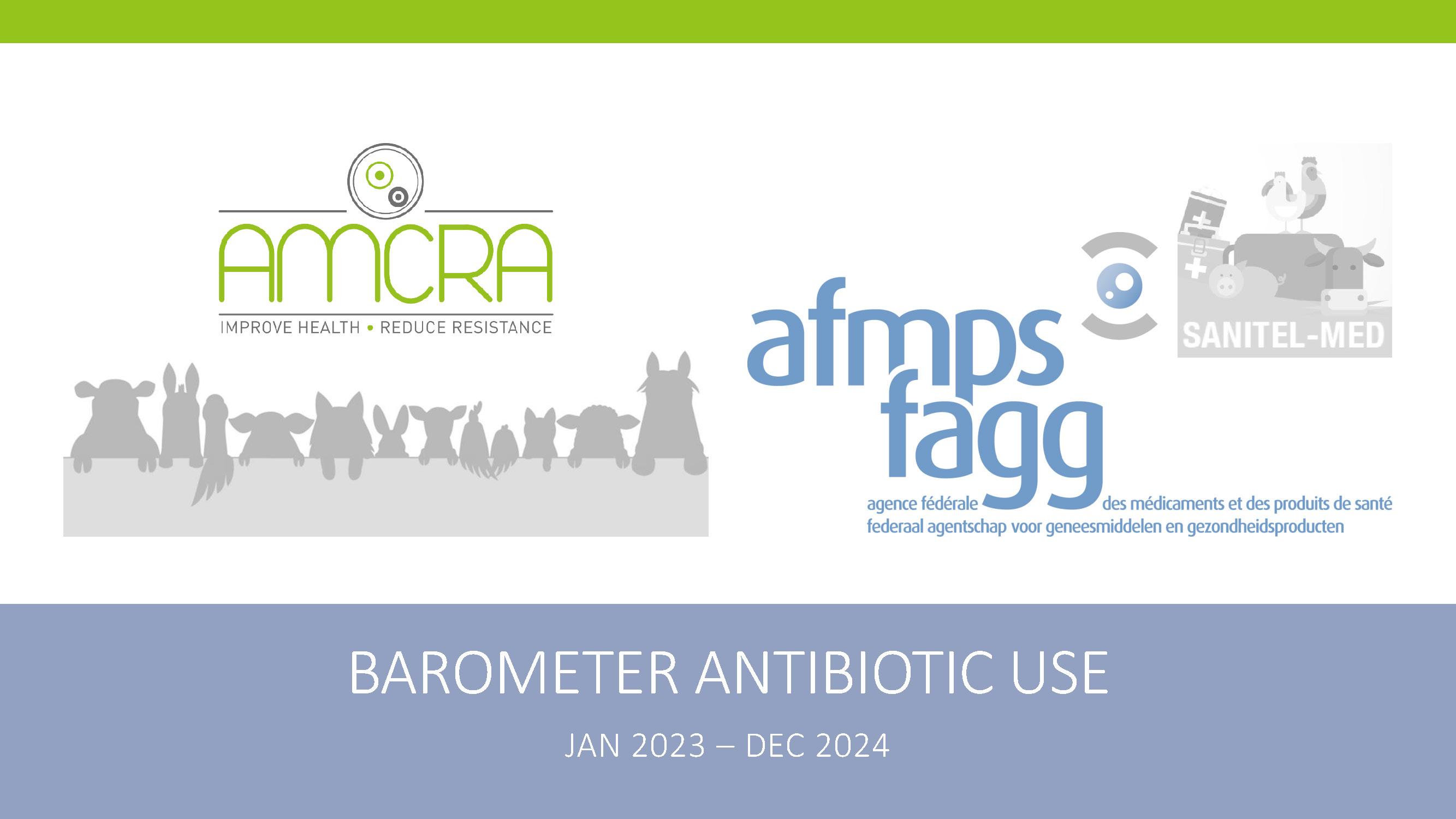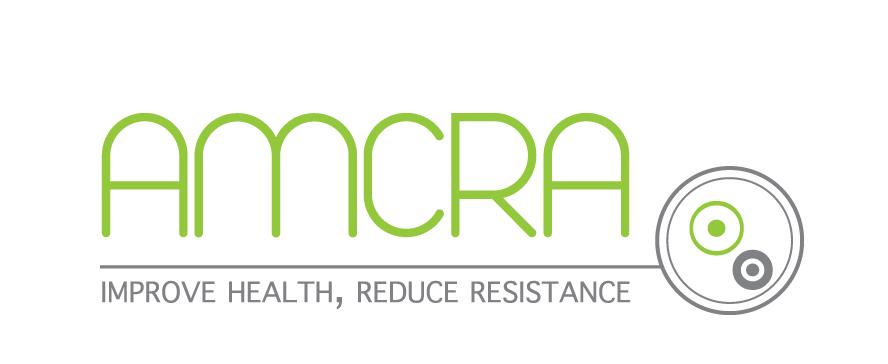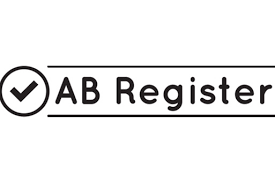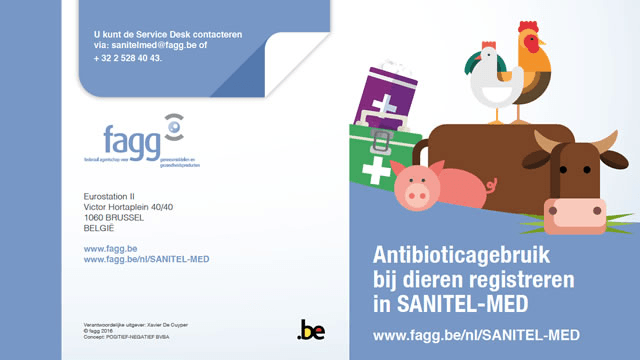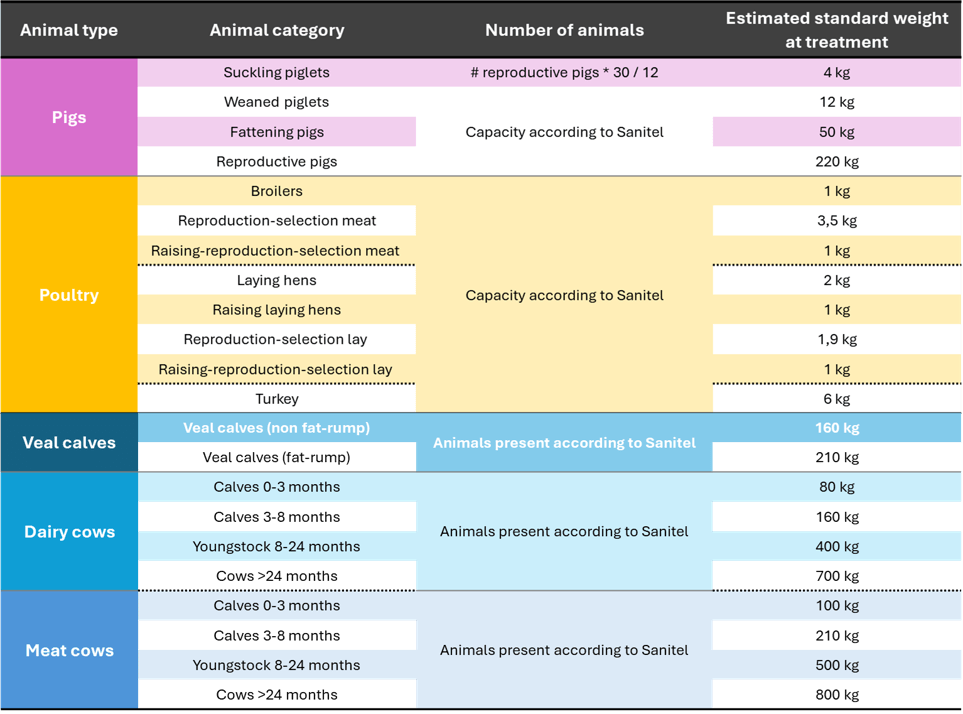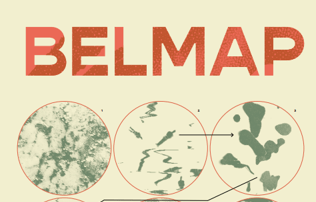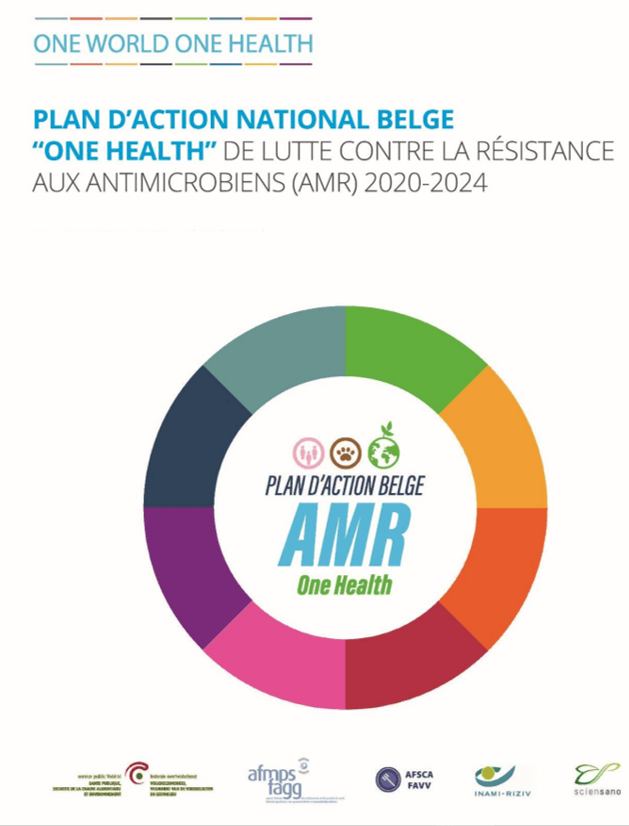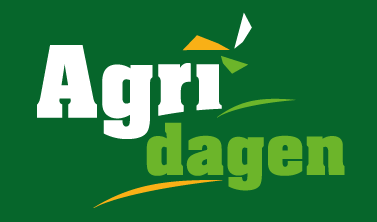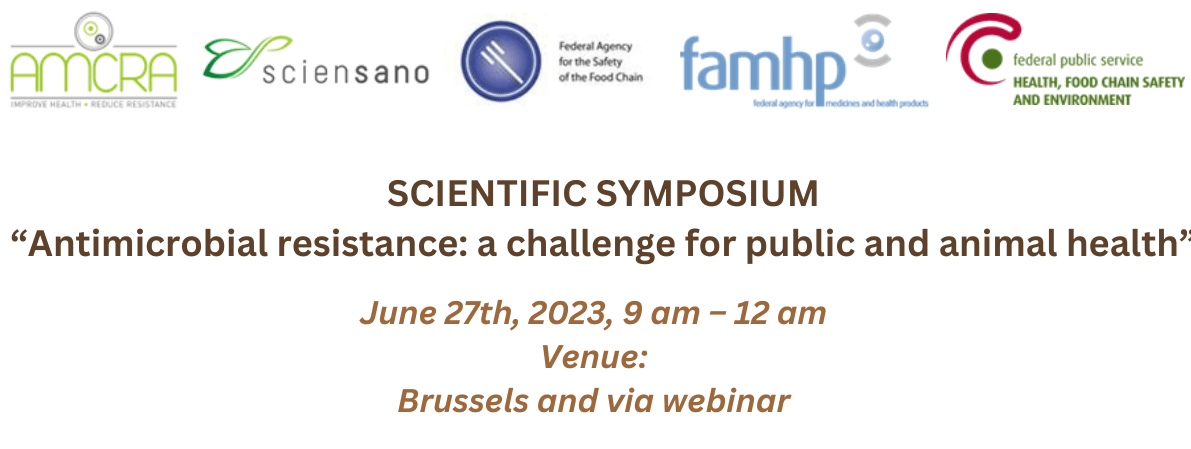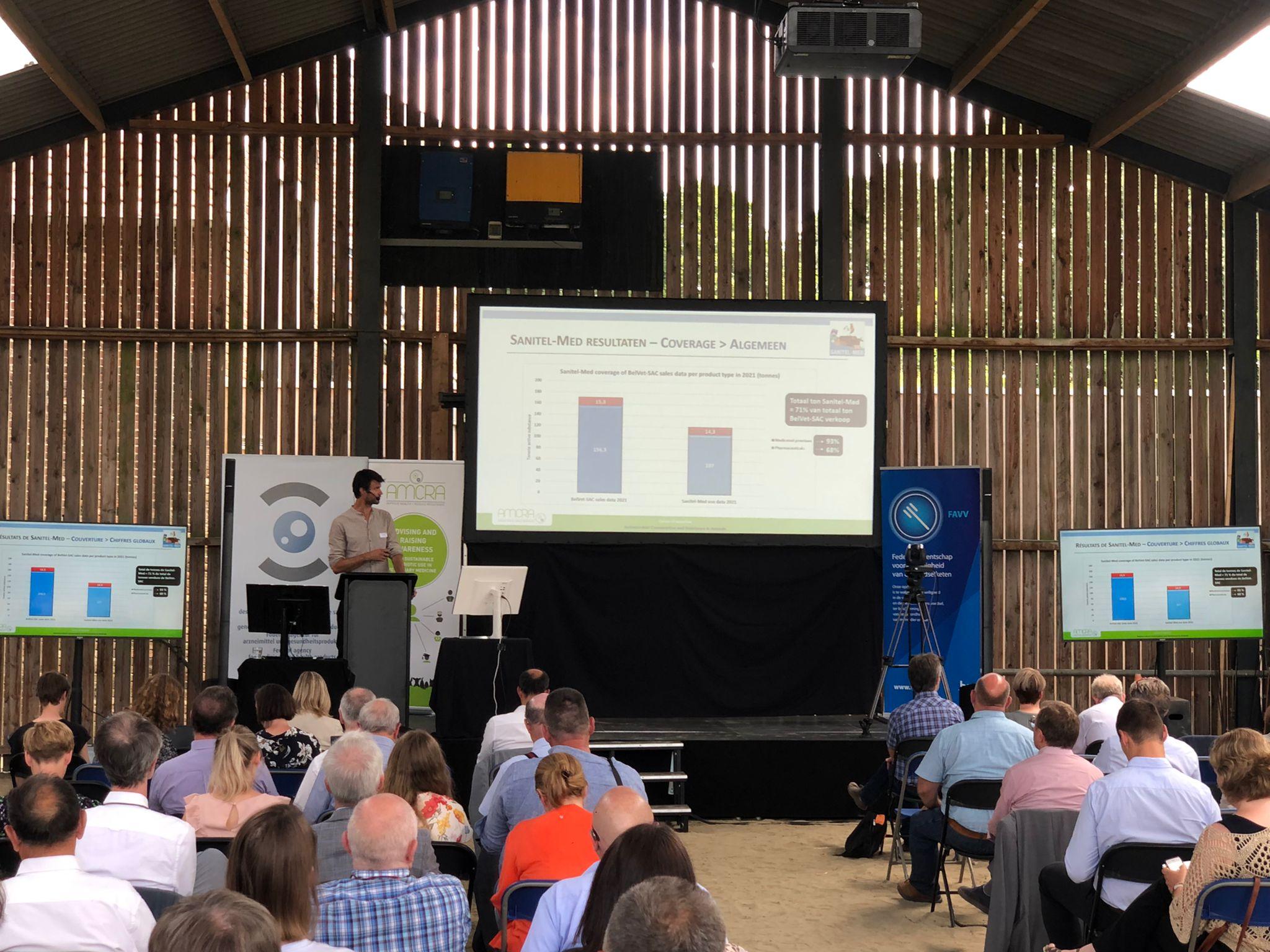What we do
The task of the 'Data Science and Analysis Unit' of AMCRA is to both analyse and report data relating to antibiotic use in animals. The focus of its work is currently on antibiotic use at farm level and in livestock (pigs, chickens, cattle).
In practice, antibiotic use notifications collected in external data collection systems are processed according to a specific methodology, to benchmarking reports for farmers and veterinarians on the one hand and reports at sector or national level on the other hand.
Periodic benchmarking reports
These are geared towards individual farmers and veterinarians.
Benchmarking reports for farmers describe and benchmark the use at a specific farm. The farmer and veterinarian(s) in question are provided with information about antibiotic use at the farm on the basis of the indicator TD100 (number of treatment days per 100 days). An essential aspect of this is the objective comparison with other farms (= benchmarking). The reports also contain qualitative data, for example regarding use of different types of antibiotics, based on their importance for animal and public health indicated by the AMCRA colour codes.
Benchmarking reports for veterinarians provide information about the extent to which a veterinarian prescribes, purchases or administers antibiotics based on a score (the Veterinary Benchmark Score, VBS) that represents the extent to which the vet is involved, as a company vet or as a supplier of antibiotics, in farms with animal categories with a green, yellow or red benchmark colour score. The VBS s a score out of 100, and the more yellow and/or red animal categories the vet is involved in , the lower the VBS will become. The veterinary benchmarking reports also contain qualitative information.
Rreports at sector or national level
These reports describe, based on the data at farm level, the antibiotic use at national level (for example, in the Sanitel-Med Barometer or the BelVet-SAC reports), at the level of a specific sector or even for a group of farms associated with a particular quality label. These reports do not only provide the latest results in, for example, the last year, but striking and/or important trends over longer periods are identified, monitored, and interpreted.
The analysis and reporting of antibiotic use plays an important role in achieving the objectives of AMCRA and its partners united in the Antibioitc-covenants and the Belgian National Action Plan on AMR. After all, "measuring is knowing": detailed information in the form of 'bespoke' reporting of antibiotic use at farm and sector level can be used in order to address and monitor (excessive) antibiotics use in a targeted way. The 'Data Science and Analysis' Unit of AMCRA therefore plays a crucial role in communication to users and suppliers of antibiotics and awareness-raising among these target groups.
In addition to its core tasks of analysis and reporting, the 'Data Science and Analysis Unit' also provides support and advice in the development and operation of the various data collection systems in Belgium concerned with antibiotic use in veterinary medicine, and it is involved in a number of (inter)national projects relating to quantification of antibiotic use in animals.
Clients
The Data Analysis Unit works in close collaboration with the managers of the datacollection systems wherein the antibiotic use in animals is registered. Through regular consultation, we aim to achieve optimum cooperation with our clients and the managers of data collection systems.
Currently, the 'Data Science and Analysis Unit' of AMCRA is working on behalf of the Belgian Federal Agency for Medicines and Health Products, in the context of the national data collection via 'Sanitel-Med' for pigs, poultry (the complete 'lay' and 'meat' branche, plus turkeys) and bovines (dairy and meat cows, veal calves). In addition, the Unit works on behalf of the 'Begrotingsfonds voor de gezondheid en de kwaliteit van de dieren en de dierlijke producten' (Sanitair Fonds), in the scope of the data collection via 'AB Register' and 'BIGAME', for pigs, poultry, dairy and meat cows in Flanders, and dairy and meat cows in Wallonia, respectively.
The indicator TD100
Antibiotic use can be expressed in a few different ways. As a basic rule, a good indicator consists of a numerator (= the number of 'technical units' used) that is standardised using a denominator (= the mass of animals).
The annual total quantity of antibiotics for animals sold in Belgium, for example, is reported in mg of active substance per kg of biomass. This is a 'weight-based' method of calculating antibiotic use, given that weight-based technical units (mg) are used.
Another method is determining animals' level of exposure to antibiotic use. This method is based on determining the treatment incidence (Timmerman et al., 2006, Prev. Vet. Med., 74, p. 251-263). Calculating the TD100 is one example of this. The TD100 is the number of Treatment Days using antibiotics per 100 days. In other words, the % of treatment days on which antibiotics were used. This is a 'dose-based' indicator, where the number of doses is the numerator.
THE PRINCIPLE OF CALCULATING THE TD100
To calculate the TD100 the quantity of antibiotics used is divided by
- the DDDAbel or Defined Daily Dose Animal defined for Belgium
- the total mass of animals that was at risk of treatment (average number of animals present multiplied by the estimated mass at the time of treatment)
- the total number of days that an animal was at risk of treatment.
Some products have a longer duration of action. The LA-factor or 'Long Acting-factor' adjusts for this extended duration of action. After all, one day of treatment with a long-acting product must be counted as more than one treatment day.
Formula for calculating the TD100:

THEREFORE:
Antibiotics for which the package leaflet recommends a small dose are weighted equally in the calculation with antibiotics for which a high dose is recommended.
AND: large farms are levelled to small farms.
AND ALSO: regardless of which period at risk is under consideration, the antibiotic use is converted into 100 days.
IN OTHER WORDS:
Antibiotic use at each farm is calculated in a standardised way, which allows for a valid comparison of farms.
DEFINED DAILY DOSE ANIMAL
Generally speaking, there are several different dose-based 'technical units' for expressing the quantity of antibiotics used, such as the defined daily dose (DDD), the used daily dose (UDD), and the defined course dose (DCD). In order to distinguish between the units used in human medicine and those in veterinary medicine, we add an 'A' (for 'animal') for the latter case.
To calculate the TD100, we apply the Belgian DDDA, the DDDAbel. These values are defined for each individual product, based on the information given in the 'summary of product characteristics'. The same applies for the LA-factors, the LAbel. Further explanation about the methodology used to define the DDDAbel and the LAbel can be found in the documents that are available to download below. Also described is how the treatment duration is determined, which is relevant to determine a standard dose of a complete treatment (DCDbel). Finally, there is a brief description of the method used to establish a DDDAbel value for products used off-label in animal species for which these products are not authorised.
The antibiotics dose lists for each species for which AMCRA is currently responsible for producing benchmarking reports (pigs, chickens, (veal) calves, cows) can be found below. These include the DDDAbel and LAbel defined for all products. The antibiotic dose lists are updated regularly. A list is also available for products used off-label in animals species for which the products are not authorised (and for which AB-registrations exist in Sanitel-Med).
WEIGHTS USED PER ANIMAL CATEGORY
Since the exact weight of the animals is not known when they are treated, an assumed weight at the time of treatment must be used. For pigs and broilers, standard weights are used that have been recommended by the European ESVAC project. For the other animal categories, weights are used that are determined in consultation with the sectors.
Benchmarking
FARMERS
All procedures applied by AMCRA with regard to calculating, checking and monitoring data quality, benchmarking and reporting antibiotic use in animals at farm level, based on data collected in Sanitel-Med, are summarized in a Standard Operating Procedure (current version July4, 2025 - in French). This includes an explanation of the calculation of the TD100, the animal numbers and standard weights used (see also above), and the method and parameters used for benchmarking and determining the benchmark color scores (see general principles below). Since publication of the Royal Decree of December 17, 2024, the AB company statute has a legal meaning with possible consequences in the event of long-term high-volume use; the principles for determining the AB company statute are summarized in a separate document (current version February 19, 2025 - in French).
Benchmarking of farmers is carried out by comparing their antibiotic use, specifically their average TD100 value during the benchmarking period, with one or two TD100 threshold values. This is done for each animal category. The benchmarking period is usually one year for pigs, poultry, and cattle, and two years for veal calves. The result is a benchmarkvalue (= average TD100) and a benchmark colour score according to a classification as a low user (green colour score), intermediate user (yellow colour score) or high user (red colour score).
In Belgium, in a first phase dynamic threshold values are applied: threshold values that change in each benchmarking report. This is because the values are recalculated for each new benchmarking report. Two threhold values are typically used: the TD100 value delineating the 10% highest users is the upper threshold value. The TD100 value delineating the 50% lowest users is the lower threshold value. Working with dynamic threshold values allows for an insight into how the sector is developing as a whole, while also identifying the farms with the highest antibiotic use in a representative way. The disadvantage of this method, however, is that farmers can never be sure what to expect in the next benchmarking report.
For this reason, in a second phase interval limit values are applied. These limit values are maintained for a longer period: the interval. The duration of the interval depends on the overall antibiotic use in the sector, the antibiotic use in other animal categories, and the lower and upper threshold values themselves.
At present, dynamic threshold values are only being used in the bovine sector. Data collection in this sector began in 2018 and the first benchmarking report for dairy farmers was published in 2019.
The switch to interval threshold values is only done once there is a sufficiently clear picture of (the evolution of) antibiotic use in a sector. This is already the case for the pig, poultry, and veal calf sectors, whose antibiotic use has already been mapped out for several years now, and communication has been established with farmers and veterinarians in these sectors via the benchmarking reports. In these sectors, the interval threshold values form part of the sector-specific reduction targets that were established in the AMCRA 2024 plan and that were defined in more detail in consultation with the sectors in late 2020.
The sector-specific reduction targets consist of the TD100 threshold values that came into effect on 1 January 2021 and gradually decrease over time, with an initial adjustment scheduled in 2023 and a provisional final adjustment in 2024. This creates a 'reduction path' for each sector, and it is already clear to all farmers at the outset what requirements they will need to comply with. The reduction paths will be monitored annually in order to assess feasibility against the situation in practice.
It is also possible to perform benchmarking for the AMCRA colour codes (yellow, orange or red) that are assigned to antibiotics (see second graph below).
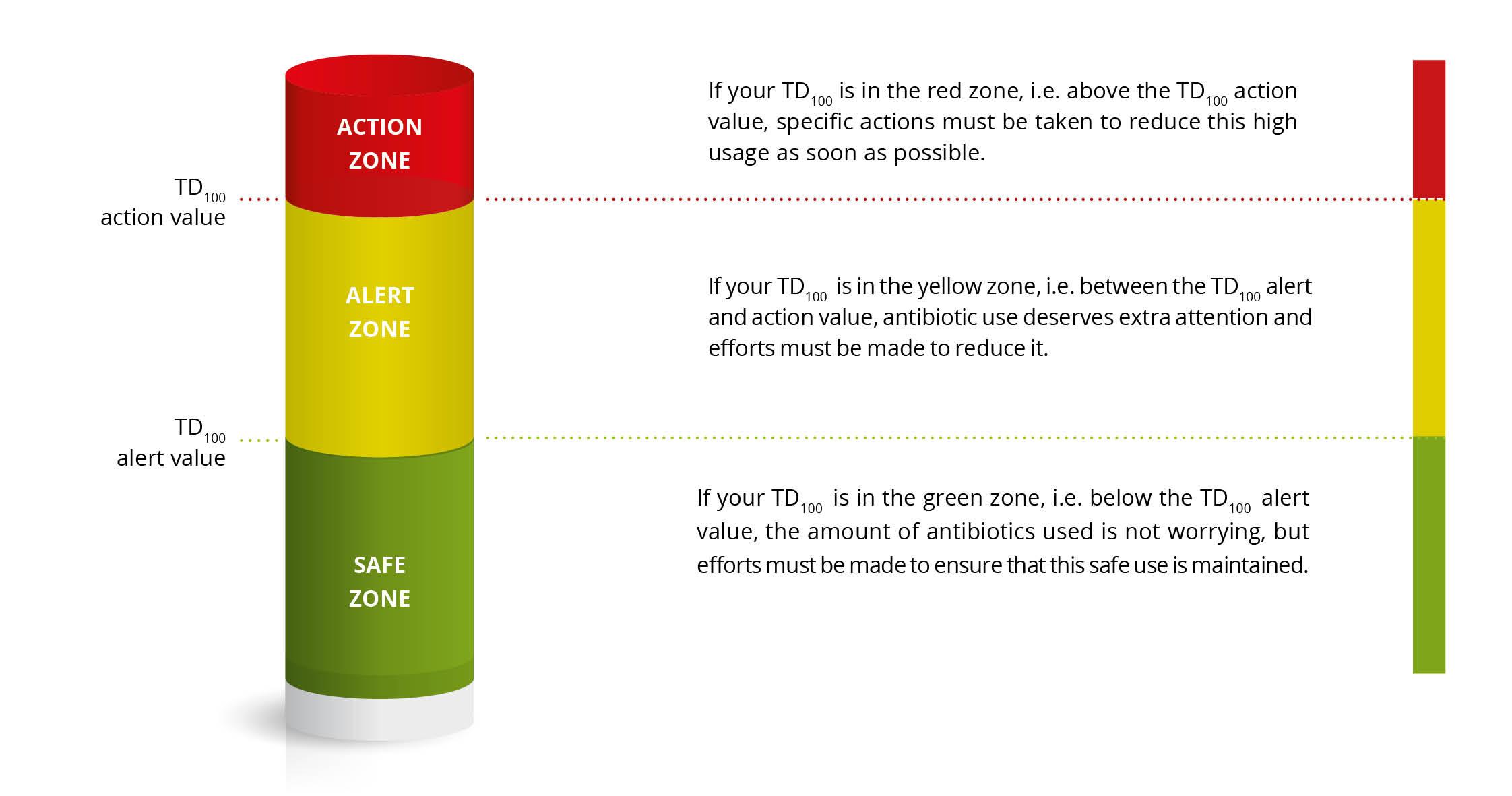
Figure: Principle of benchmarking using two limit values.
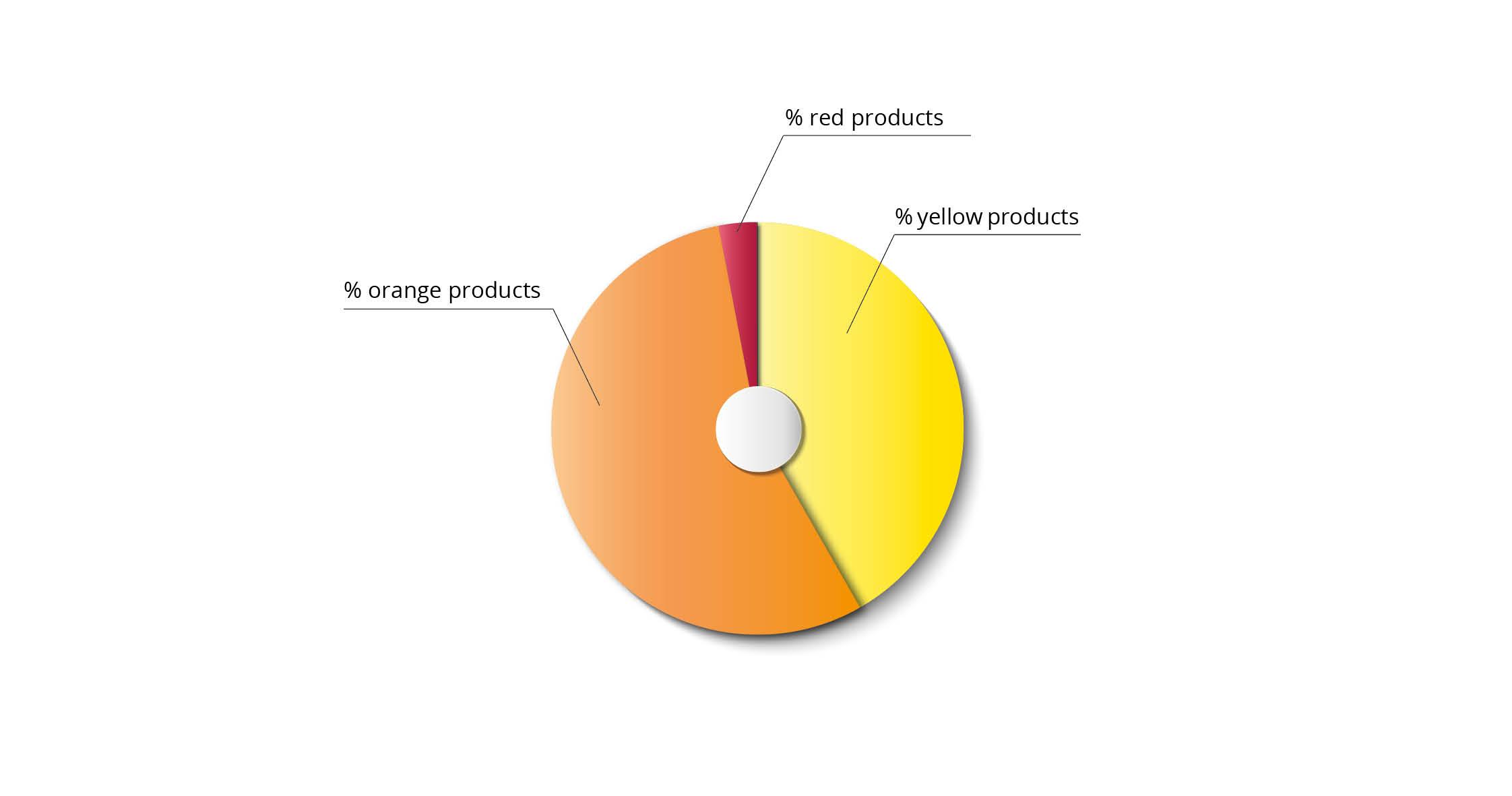
Figure: Example of division of the number of treatment days by products with their various AMCRA colour codes.
VETERINARIANS
The methodology for benchmarking veterinarians is also described in a Standard Operating Procedure (current version 23 May 2024 - in French).
In concrete terms, benchmarking is done using a Veterinary Benchmark Score (VBS), a figure out of 100 that reflects the benchmark results of a veterinarian's contract companies and non-contract companies where a veterinarian provides antibiotics. A 'contract company' is defined as a company with which the veterinarian had a contract as a company veterinarian for at least half (= 183 days) of the benchmark period (= one year).
In concrete terms, the VBS reflects the extent to which a veterinarian contributes to green, yellow and red animal categories.
As for livestock farmers, two threshold values are determined for the VBS that divide veterinarians into 50% 'low suppliers', 40% 'attention suppliers' and 10% 'high suppliers'.

Figure: The benchmarking of veterinarians based on the Contract Score and two threshold values.
Sector-specific TD100 threshold values


Barometer Antibiotic Use
Every quarter, the FAMHP and AMCRA publish the 'Antibiotic Use Barometer', based on the mandatory registration of antibiotic use in Sanitel-Med. This shows a number of trends with regard to antibiotic use per animal species (pigs, poultry, veal calves, dairy and beef cattle): the evolution of the total annual use in each animal species (both in tonnes and in BD100, with insight into the number of companies without antibiotic use), each time shifting by a quarter of new data; the use of a number of veterinary important antimicrobial families, i.e. the polymyxins (colistin) and the two families with a red AMCRA colour code, i.e. the (fluoro)quinolones and the 3rdand 4th generation cephalosporins; and the share of companies per benchmark colour score and the number of tonnes of antibiotics used by the companies with these colour scores.
